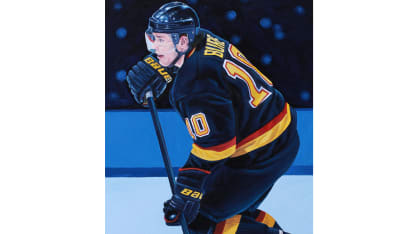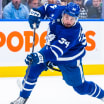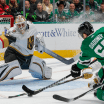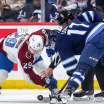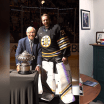As part of the NHL Centennial Celebration, renowned Canadian artist Tony Harris will paint original portraits of each of the 100 Greatest NHL Players presented by Molson Canadian as chosen by a Blue Ribbon panel. NHL.com will reveal two portraits each Monday in 2017.
This week, the portraits of forwards Toe Blake and Pavel Bure are unveiled in the 27th installment.
Blake, Bure portraits unveiled
Color paintings of 100 Greatest NHL Players will be revealed on NHL.com every Monday in 2017
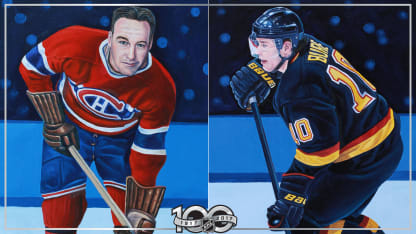
By
NHL.com @NHLdotcom
Toe Blake was one-third of one of the most famous trios in NHL history. He played left wing on the famed "Punch Line" of the Montreal Canadiens, with Elmer Lach in the middle and Maurice Richard on right wing. They helped revive the Canadiens after one of the few downturns in franchise history and keyed Montreal's Stanley Cup championship teams in 1944 and 1946.
Some people felt Blake was the embodiment of old-time hockey; he once tried to take on the entire Detroit Red Wings team. But Blake also served as Montreal's captain from 1940-48, was skilled enough to lead the NHL in scoring in 1938-39, and was named to the NHL First All-Star Team three times. Blake's playing career came to a premature end on Jan. 11, 1948, when a collision with Bill Juzda of the New York Rangers resulted in a badly broken leg and forced him to retire at 35. Seven years later, he returned to the Canadiens as coach and guided them to eight championships in 13 seasons.
In his
NHL100 profile of Blake
, author Stu Hackel wrote that the player nicknamed The Old Lamplighter was the one the Canadiens rebuilt around after missing the playoffs in 1939-40:
"When coach Dick Irvin moved from [the] Toronto [Maple Leafs] to Montreal in the summer of 1940, he saw only one bona fide NHL player on the Canadiens roster: Blake. He made Toe captain and started to rebuild around him.
"Lach arrived that year, and the promising Richard came in 1942. A series of injuries to Richard caused concern that he might be too brittle for the NHL. After he started 1943-44 skating with Blake and Lach, another injury soon sidelined him. He returned to the lineup playing with others. But during a schedule break around Christmas, Irvin traveled to Saskatchewan to visit his family, leaving Blake to run practices. Foreshadowing his future as a coach, Blake put Richard and Lach back on a line with him, and Irvin kept them together when he rejoined the team for the Dec. 30 game against the Red Wings. That night, Richard -- who had four points on the season -- got three goals and two assists in an 8-3 win. The 'Punch Line' was born, and hockey was never the same.
"'That's when my career really got going,'" Richard told famed broadcaster Dick Irvin, the coach's son, for his book "The Habs: An Oral History of the Montreal Canadiens 1940-80." "Richard spoke no English at first and Lach spoke no French. Blake handled the translating and much more. Lach told the author Irvin that Blake 'was good for me and Rocket. We called him "The Old Man." He was in his 30s. One thing about Toe was the way he practiced. Boy, how he would work. He always said, "The way you practice is the way you played." He never fooled around in practice. That's what made us successful.'
"Richard had 30 goals in the season's last 30 games, becoming the most explosive performer the game had seen, aided by his linemates. Each had a role. Although strong shooters themselves, Blake and Lach gladly hunted and fought for pucks to feed Richard, who was nearly unstoppable inside the blue line. All three understood where to be in certain situations and they could move the puck to each other without looking. 'I knew by feel,' Lach told the author Irvin. 'It was very clear in my mind.'
"Richard was overjoyed to skate with the Canadiens star he had admired as a teenager. 'My hero was Toe Blake,' he told author Roger Kahn."
Artist Tony Harris said that because Blake was better known as a coach than a player, finding a picture of him in a Canadiens uniform rather than behind the Montreal bench wasn't easy.
"There might be hundreds of photos of Toe Blake behind the Canadiens bench or drinking from the Stanley Cup," he said. "However, there are not many of him in uniform, and so the image I used was a black-and-white promotional shot. Adding color to these old images is a bit challenging, but it's also very rewarding."
Pavel Bure came along more than 40 years after Blake's playing career ended, and he wasted no time becoming a star. He made his NHL debut as a 20-year-old with the Vancouver Canucks on Nov. 5, 1991, and quickly earned the nickname The Russian Rocket after jumping from CSKA Moscow in his hometown to the NHL.
After scoring 34 goals as an NHL rookie in 1991-92, Bure took off with back-to-back 60-goal seasons. He had the kind of goal-scoring fire that fans love, and the crowds at Pacific Coliseum quickly made him a favorite. His end-to-end rushes made life miserable for opponents but lifted fans out of their seats. His overtime goal in Game 7 of the 1994 Western Conference Quarterfinals eliminated the Calgary Flames and sparked the Canucks to a run that didn't end until they lost 3-2 to the New York Rangers in Game 7 of the Stanley Cup Final.
But Bure's run in Vancouver ended after a battle with management saw him traded to the Florida Panthers on Jan. 17, 1999.
He showed fans in South Florida that his scoring touch was alive and well by leading the NHL in goals with 58 in 1999-2000 (despite coming off knee surgery) and 59 in 2000-01. But after Bure scored 22 goals in 56 games for the Panthers in 2001-02, he was traded to the Rangers. Despite scoring 12 goals in 12 games after the trade, Bure couldn't lift New York into the playoffs.
He played 39 games for the Rangers in 2002-03, but more knee issues and operations ended his career shortly before his 32nd birthday. In 702 NHL games, he had 779 points (437 goals, 342 assists), as well as 70 points (35 goals, 35 assists) in 64 playoff games.
Author John MacKinnon, in his
NHL100 profile of Bure
, wrote about Bure's legacy with the Canucks:
"By consensus in Vancouver, Bure easily remains the best and most exciting player to don a Canucks jersey. The Canucks and Bure repaired their relationship over time, and Vancouver retired his No. 10 on Nov. 2, 2013.
"It was well deserved. With his blinding speed and offensive flair, Bure was a rare player who consistently delivered art on ice, when he was healthy.
"'I loved to score, but I was trying to do something creative, to beat the guys with different moves,' Bure said in 2012 upon his induction into the Hockey Hall of Fame. 'Then, you didn't have [the] internet, or so many cameras. You had to go on the ice and do something there so that people would go talk to their friends and say, "Maybe it's fun to go watch that team or that player."
"'That's something I wanted to do.'"
Harris' portrait of Bure is from his early days with the Canucks.
"During Pavel Bure's career with the Canucks, the team went through a few uniform refinements and Bure himself even changed numbers," Harris said. "After a long deliberation, the prominently black version with the No. 10 won out."
Toe Blake
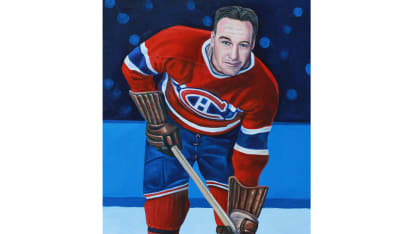
Pavel Bure
